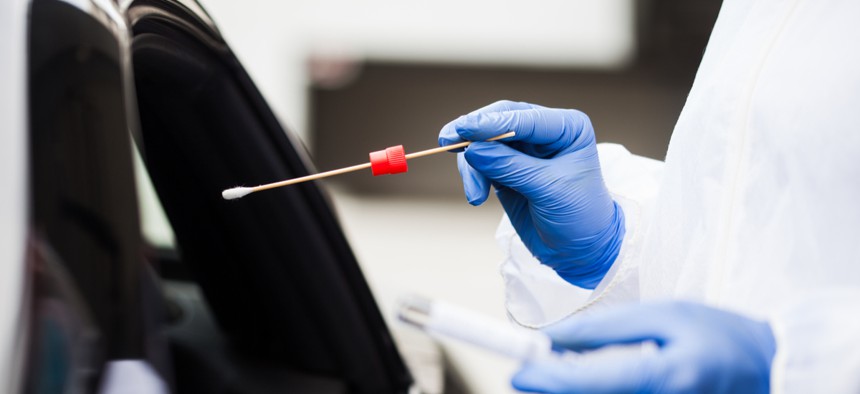Establishing Covid-19 Testing Sites for All

Testing has been a persistent challenge throughout the Covid-19 pandemic. Buffalo, New York officials worked with their community to identify and set-up testing sites in communities that are most at-risk. SHUTTERSTOCK
COMMENTARY | Racial and socioeconomic inequities continue to be exacerbated during the Covid-19 pandemic. Community leaders must engage residents who are most vulnerable to identify equitable response measures.
As Covid-19 cases continue to surge across the country, making sure everyone has access to the care, testing and support they need is crucial to containing the virus and enabling states to stay open safely. A good place to start is asking and listening to residents from the neighborhoods that have been most impacted by the disease about what they need, which is what we did in Buffalo.
Since the beginning of the pandemic started, we’ve engaged directly with block clubs, faith leaders and community advocates to identify potential gaps in our response, particularly around our testing approach. From these conversations, we learned that one option we were exploring—a drive-in only testing site—would severely limit access for too many residents. If our goal was to test those most at risk for the coronavirus, we needed a site within walking distance to accommodate people who don’t have a car or drive.
That guidance from the community, as well as from county officials, led us to convert a library in the heart of a Black neighborhood with the highest number of coronavirus cases into a walk-in and drive-thru testing venue so everyone could access it. The community dialogue also led us to establish Covid-19 testing sites along common bus routes to make it easier for essential workers to get tested on their way to or from work. And we co-located testing sites in heavily trafficked community centers that also serve as food banks for food-insecure families.
As a Black man whose work centers on citizen engagement, I also decided to get tested even though I had no Covid-19 symptoms. I did it to be a role model and assuage fears among a community with a historic distrust of the medical system. When I tested positive, it was a shock since I was asymptomatic. But I seized the opportunity to share my experience with others and educate the contact tracer who followed up about how to convey health information in a culturally sensitive manner.
These efforts are hardly remarkable. They are common sense steps to make sure no community is left behind, can survive a pandemic and thrive when it’s over.
Yet, our actions seem remarkably unique.
Many localities across the country aren’t soliciting input from people in the most affected communities to inform their Covid response, as well as reopening and recovery efforts. This is evident in multiple studies that have found that people in communities of color, who face a higher risk of coronavirus infections, hospitalizations and deaths, don’t always have the access to the care they need, particularly when it comes to testing.
An NPR investigation examining the location of testing sites in Texas—one of the first states to reopen after the first round of lockdowns and is now a Covid-19 hotspot—revealed that in four of six of the largest cities, testing sites were disproportionately located in whiter neighborhoods. Similar patterns have been seen in black communities across the south like in rural Alabama and across much of the Black Belt. Similarly, another study found that Black Americans face an above-average risk of living in a testing desert, and in areas where cases are increasing.
As more hotspots emerge, the location of testing sites is critical to controlling outbreaks and identifying who is infected. Given how important testing and contact tracing are for a full recovery, state and local policymakers should be talking to community members most at-risk for direction to avoid exacerbating inequities.
Recently issued health equity principles for coronavirus recovery could steer leaders in that direction. These principles urge localities to promote fairness and equity by asking: do people facing the greatest need have access to testing and treatment? And, are we creating ways for residents, particularly those who are hardest hit, to meaningfully participate in and shape the government’s recovery strategy?
For communities to recover fully and fairly, state and local policymakers must create spaces for leaders in harder hit communities to be at decision-making tables. That means regularly consulting with community-based organizations that can identify barriers to accessing health and social services, offer sensible solutions and disseminate public health guidance in culturally and linguistically appropriate ways.
We’ve been doing that in Buffalo even before the pandemic hit. As director of citizen services, I have worked closely with community leaders to reduce social isolation in a city with long, cold winters. Because we already were working together to connect neighbors and more effectively use public spaces to build community, we didn't have to start from scratch to cultivate relationships. We built on that foundation, and on the deliberate and meaningful partnerships with faith leaders, residents, community organizations, health care providers, county officials and the mayor. All that work has helped us respond to Covid-19 in ways that are fostering health equity.
As our nation grapples with past and present racial injustices, we must recognize and reform the ways in which the systems designed to protect all of us fail to meet that goal. A person’s race shouldn’t dictate opportunities for good health. For coronavirus testing to be accountable to all—especially people of color—we have work to do. It starts with asking and listening and ends with real, systemic change.
Oswaldo Mestre is the Chief Service Officer & Director of Citizen Services for the City of Buffalo, NY. He works with residents, block clubs and organizations to better service the community, through programs aimed at supporting the rejuvenation of inner-city neighborhoods.
NEXT STORY: Feds Will Reopen Schools on Native American Reservations





